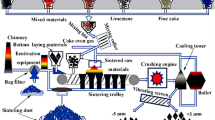Abstract
The increasing use of zinc-containing scrap for steel production has lead to a high zinc content in the electric arc furnace and converter flue dusts. The cost of disposing of this residue is high due to environmental restrictions. Various recycling processes have been developed for these dusts, but most never reached the pilot plant stage and many investigations were stopped because of metallurgical and economical inefficiencies. While pyrometallurgical methods have to deal with high energy consumption, low zinc yield, and valueless residues, hydrometallurgical processes could offer an economical recycling alternative. This paper describes hydrometallurgical methods for recovering zinc from steel industry dust. These methods can be integrated in the primary zinc-winning process or in galvanization. Investigations of sulfuric-acid leaching show high zinc solubility but also a high iron content in the final liquor. As a result, steps for purification are required that cannot be conducted economically. Alternatively, a NaOH leaching gives a satisfying zinc yield and a very low solubility for the iron that remains in the residue.
Similar content being viewed by others
References
N.L. Piret and D. Müller, “Beurteilungskriterien der Verarbeitung von Reststoffen mit niedrigem Zinkgehalt aus der Eisen- und Stahlproduktion,” Erzmetall, 46 (1993), pp. 364–368.
“Zinc Recycling” (Brussels: Int. Zinc Assoc. Europe, 1999).
G. Harp, R. Klima, and R. Steffen, “Examination and Assessment of Application Possibilities of Various Processes for Treatment of Iron and Steelwork Residual and Waste Materials,” Final Report (Luxenbourg: Commission of the European Communities, 1990).
F.L. Nyirenda, “The Processing of Steelmaking Flue-Dust: A Review,” Minerals Eng., 4 (7–11) (1991), pp. 1003–1025.
J.K. Pargeter, “The Missing Link: Steelmaking By-products to Useful Raw Materials,” Steel Mill Wastes and By-Products Conf. Proc. (Sendai, Japan: Dept. of Metallurgy, Chiba Institute of Technology, 1996), pp. 127–135.
J.M.L. Arze, “Hydrometallurgische Aufarbeitung Pb-, Zn-, Sn-haltiger Flugstäube” (Degree Dissertation, Univ. of Delft, 1992).
G. Ye, J. White, and L.-Y. Wei, “Association of Halogens in Electric Arc Fumace Dust and Zinc Oxide Fume Before and After Leaching,” Global Symposium on Recycling and Waste Treatment, REWAS 99, ed. I. Gaballah, J. Hager, and R. Solozabal (Warrendale, PA: TMS, 1999), pp. 1503–1510.
J. Krüger and R. Püllenberg, “Überlegungen zum Eisenproblem bei der hydrometallurgischen Zinkgewinnung,” Erzmetall, 34 (1981), pp. 380–387.
S. Yamashita, K. Hata, and S. Goto, “Reduction Roasting for Effective Leaching of Zinc from Calcine or Zinc Leaching Residue,” Zinc & Lead ’95 (1995), pp. 818–827.
R.L. Nyirenda, “The Reduction of Zinc-rich Ferrites and its Implication for a Caron-type Process for Carbon Steelmaking Dust” (Degree Dissertation, Technical University of Delft, 1992).
Author information
Authors and Affiliations
Additional information
For more information, contact J. Antrekowitsch, University of Leoben, Nonferrous Metallurgy Department, Franz-Josef-Str. 18, Leoben, Styria A-8700, Austria; +43-3842-402322; fax +43-3842-402627; e-mail antreko@unileoben.ac.at.
Rights and permissions
About this article
Cite this article
Antrekowitsch, J., Antrekowitsch, H. Hydrometallurgically recovering zinc from electric arc furnace dusts. JOM 53, 26–28 (2001). https://doi.org/10.1007/s11837-001-0008-9
Issue Date:
DOI: https://doi.org/10.1007/s11837-001-0008-9




